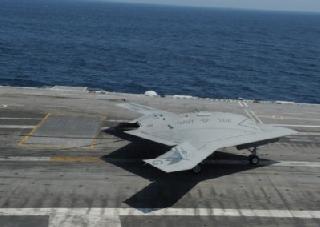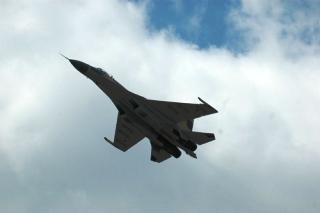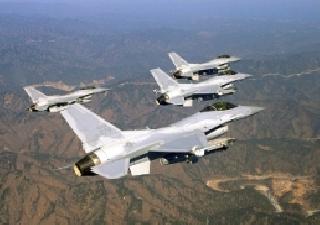
The X-47B UCAS demonstrator completes an arrested landing on the flight deck of aircraft carrier USS George H.W. Bush (CVN 77). The landing marks the first time any unmanned aircraft has completed an arrested landing at sea. A US Navy photo
NAVAL AIR STATION PATUXENT RIVER (BNS): A prototype of the US Navy's X-47B unmanned combat air system (UCAS) has completed first carrier-based arrested landing on the flight deck of aircraft carrier USS George H.W. Bush (CVN 77) off the coast of Virginia.
The US Navy achieved the new milestone on Wednesday when the Northrop Grumman-built tailless, autonomous stealth plane completed the 35 minute journey from Pax River to the carrier and caught the three-wire with the aircraft's tailhook.
The arrested landing effectively brought the aircraft from approximately 145 knots to stop in less than 350 feet.
Shortly after the initial landing, the aircraft was launched off the ship using the carrier's catapult. The X-47B then executed one more arrested landing, the Navy said.
"Today's historic carrier landing and our operations aboard USS George H.W. Bush show, beyond a shadow of a doubt, that tailless unmanned aircraft can integrate seamlessly and operate safely from an aircraft carrier at sea," said Capt. Jaime Engdahl, Navy UCAS programme manager.
The demonstration was the final part of three at-sea test periods for the X-47B during the last eight months.
The pilotless aircraft, which boasts of a wingspan of more than 62 feet (wider than that of an F/A-18 Super Hornet), began its carrier-based flight demonstrations in December last year from onboard USS Harry S. Truman (CVN 75).
After successfully completing the flight trials, the X-47B undertook carrier deck operations from aboard USS George H.W. Bush in May, during which period it completed the first-ever catapult launch.
While the X-47B is not intended for operational use, the US Navy, through the UCAS programme, has developed the concept of operations and demonstrated the technology for follow-on unmanned carrier based aircraft.
The Navy is reportedly planning to deploy such stealth drones in Asia in order to maintain its crucial edge over its potential adversary, China.
 Previous Article
Previous Article Next Article
Next Article











The Indian Air Force, in its flight trials evaluation report submitted before the Defence Ministry l..
view articleAn insight into the Medium Multi-Role Combat Aircraft competition...
view articleSky enthusiasts can now spot the International Space Station (ISS) commanded by Indian-American astr..
view article